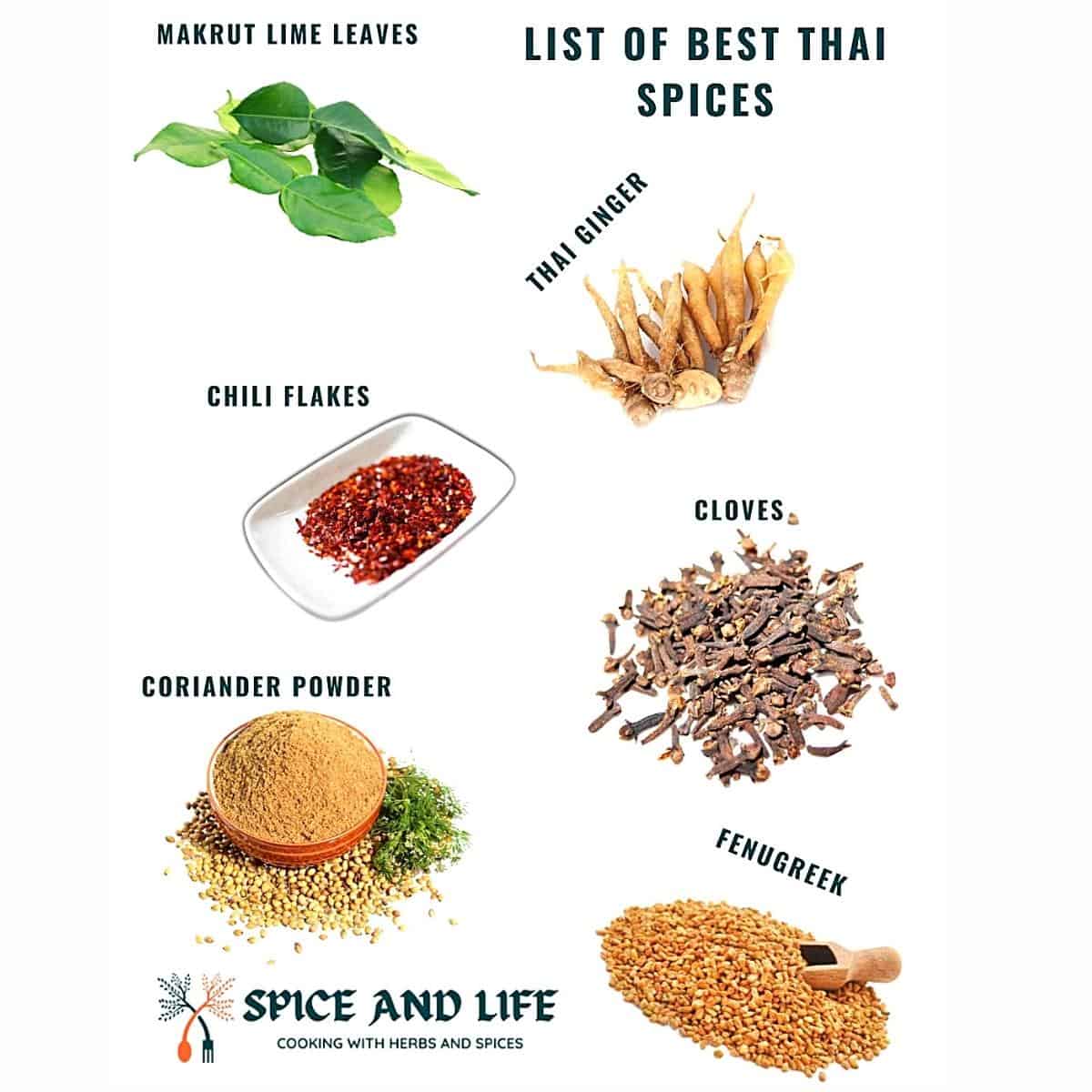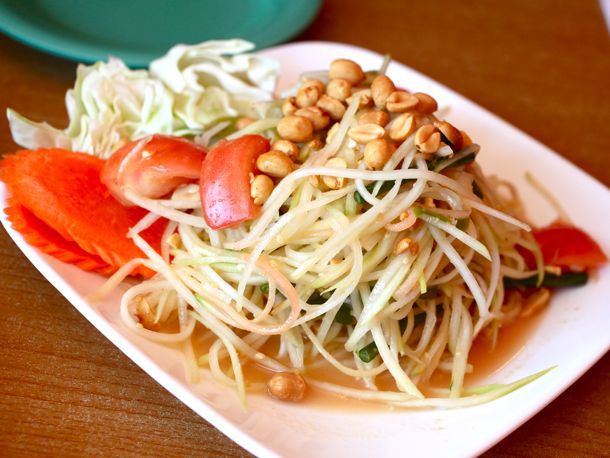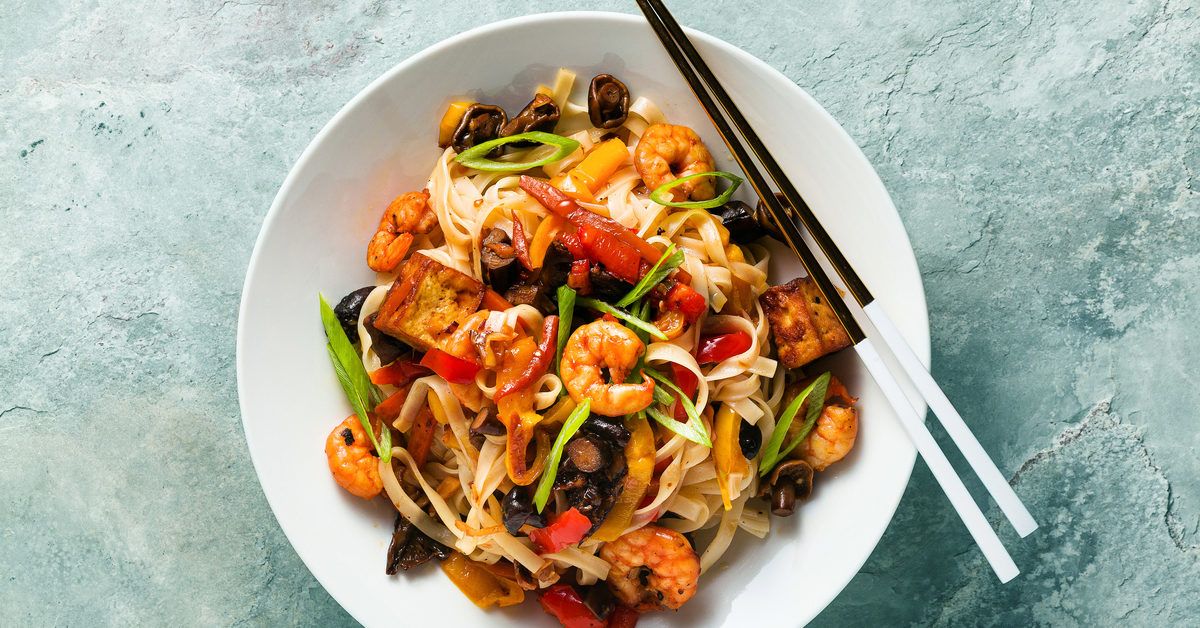What Makes Thai Food Spicy

Thai food gets its spiciness from key ingredients that are commonly used in Thai cuisine. One of the main culprits is chili peppers, which are added to dishes in different forms including fresh, dried, or as a paste. Thai cuisine also incorporates other spicy elements such as ginger, garlic, lemongrass, and galangal, which contribute to the overall heat of the dish. The combination of these ingredients creates the distinct and fiery flavors that Thai food is known for. It’s important to note that spice levels can vary depending on the dish and the region in Thailand where it originates.
Key Ingredients In Thai Cuisine That Contribute To Spiciness
Thai cuisine incorporates several key ingredients that contribute to its spiciness. Chili peppers are the primary culprits, adding a fiery kick to dishes. They can be used in various forms, such as fresh chilies, dried chili flakes, or as a chili paste. Additionally, ginger, garlic, lemongrass, and galangal are commonly used in Thai cooking, enhancing the overall heat of the dish. These ingredients not only provide heat but also add depth and complexity to the flavors of Thai cuisine. Together, they create the renowned spicy profile that Thai food is known for.
Understanding The Use Of Chili Peppers In Thai Cooking
Chili peppers are a staple ingredient in Thai cuisine, playing a significant role in adding heat and flavor to dishes. Thai cuisine utilizes a variety of chili peppers, including bird’s eye chili, Thai chili, and long chili, each with its own level of spiciness. These peppers are used in different forms, such as fresh, dried, or as a chili paste, depending on the dish’s desired level of spiciness. The use of chili peppers not only provides a fiery kick but also enhances the depth and complexity of flavors in Thai cooking.
Common Spice Levels In Thai Food

Thai food is known for its spicy flavors, but the level of spiciness can vary. The common spice levels in Thai food are mild, medium, hot, and Thai hot. Mild spice level is suitable for those who prefer a milder taste with just a hint of spiciness. Medium spice level provides a moderate amount of heat, adding a kick to the dish without overwhelming the taste buds. Hot spice level is for those who enjoy a fiery sensation, while Thai hot is the highest level of spiciness, offering an intense and authentic Thai flavor experience.
Mild, Medium, Hot, And Thai Hot Spice Levels Explained
Mild, Medium, Hot, and Thai hot spice levels are commonly used in Thai cuisine to indicate the level of spiciness in a dish. Mild spice level offers a subtle hint of spiciness, suitable for those who prefer a milder taste. Medium spice level provides a moderate amount of heat, adding a kick to the dish without overwhelming the taste buds. Hot spice level intensifies the heat, while Thai hot is the highest level of spiciness, offering an intense and authentic Thai flavor experience. It’s important to communicate your preferred spice level when ordering to ensure the dish suits your taste.
Variations In Spice Levels Across Different Regions In Thailand
Across different regions in Thailand, there are variations in spice levels in their cuisines. In Northern Thailand, dishes tend to be milder, focusing more on the use of aromatic herbs to enhance flavors. However, in Northeastern Thai cuisine, such as Isaan, the dishes are famous for their intense spiciness. The use of chili peppers and other spices in these regions varies, resulting in a diverse range of flavors and heat levels. It is important to be aware of these regional differences when exploring Thai cuisine and to communicate your preferred spice level when ordering.
Ordering Spicy Food In Thailand

When dining in Thailand, it is important to communicate your preferred spice level when ordering. To do so, you can use the phrase “ped noi” for mild, “ped” for medium, “ped mak” for hot, or “ped Thai” for Thai hot. It’s perfectly acceptable to request a specific level of spiciness to suit your taste. However, it’s also important to be mindful of the traditional spiciness of certain dishes, such as Tom Yum soup or Papaya Salad. When in doubt, it’s best to start with a milder spice level and gradually increase if desired.
Tips On How To Communicate Your Preferred Spice Level When Ordering
When ordering spicy food in Thailand, it’s important to effectively communicate your preferred spice level. Here are some tips to help you convey your preferences to the waitstaff:
- Use basic Thai phrases: Learn and use phrases such as “ped noi” (mild), “ped” (medium), “ped mak” (hot), or “ped Thai” (Thai hot) to indicate your desired spice level.
- Point at the spice levels: If there is a spice level chart or menu, you can simply point at the level you prefer.
- Use hand gestures: Use your fingers to indicate the level of spiciness you want. For example, hold up one finger for mild and five fingers for Thai hot.
- Seek recommendations: If you’re unsure, ask the waitstaff for their recommendations based on your spice tolerance.
- Start with milder spice levels: If you’re not accustomed to spicy food, it’s best to start with a milder spice level and then gradually increase if desired.
Remember to be polite and respectful when communicating your preferences to ensure a pleasant dining experience.
Etiquette Around Requesting Spiciness Adjustments In Thai Restaurants
When dining at a Thai restaurant and requesting spiciness adjustments, it is important to approach the situation with respect and politeness. Thai cuisine is known for its bold flavors, including spiciness, so it is understandable that some dishes can be quite spicy. When asking for a milder spice level, it is best to politely communicate your preference to the waitstaff and ask if it is possible to adjust the spiciness accordingly. It is important to remember that the chef’s intention is to deliver an authentic Thai flavor, so be understanding if some adjustments are limited.
Managing Spice Levels In Thai Dishes

When it comes to managing spice levels in Thai dishes, there are a few strategies you can use. Traditional condiments such as lime juice, fish sauce, and sugar can help balance out the heat and add complexity to the flavors. Another option is to order extra rice or noodles to mix in with the dish, diluting the spiciness. If a dish is still too spicy for your liking, you can cool down your palate by drinking cold water, eating yogurt or ice cream, or even chewing on a plain piece of bread. Remember, it’s all about finding the level of spiciness that suits your preference!
Traditional Condiments And Side Dishes To Balance Heat
Traditional Thai cuisine offers a range of condiments and side dishes that can help balance the heat in spicy dishes. Lime juice is one popular condiment that can add a refreshing acidity to counteract the spiciness. Fish sauce, with its complex umami flavors, can also help mellow out the spice. Additionally, adding a sprinkle of sugar can help balance the heat and add a touch of sweetness. Traditional side dishes like rice or noodles can be mixed in with the dish to dilute the spiciness, providing a milder bite. These traditional condiments and side dishes are essential tools in managing spice levels in Thai cuisine.
Effective Ways To Cool Down Your Palate If A Dish Is Too Spicy
If you find yourself struggling with the spiciness of a Thai dish, there are several effective ways to cool down your palate. Here are some tips:
- Drink milk or eat dairy products: Milk and dairy products contain casein, a protein that helps neutralize the spiciness.
- Eat something starchy: Consuming foods like bread, rice, or potatoes can help absorb the heat and provide relief.
- Sip on a cold beverage: Cold water, iced tea, or a soothing drink like coconut water can help alleviate the burning sensation.
- Eat cooling fruits: Watermelon, cucumber, and pineapple are refreshing fruits that can help cool down your mouth.
- Avoid drinking alcohol or hot beverages: These can intensify the spiciness and make the burning sensation worse.
Remember, everyone’s tolerance for spice is different, so it’s important to find what works best for you to cool down your palate.
Popular Spicy Thai Dishes

Popular Spicy Thai Dishes are known for their explosive flavors and intense heat. One of the most iconic and well-known spicy dishes is Tom Yum Goong, a hot and sour shrimp soup packed with aromatic herbs and spices. Another popular dish is Green Curry, made with a spicy curry paste, coconut milk, and a variety of vegetables and proteins. Pad Thai, a stir-fried noodle dish, can also be made spicy by adding extra chili peppers. Other spicy favorites include Spicy Basil Chicken (Pad Krapow Gai) and Red Curry (Gaeng Ped). These dishes showcase the bold and fiery side of Thai cuisine.
Exploring Iconic Thai Dishes Known For Their Spiciness
Some of the most iconic Thai dishes are known for their spiciness. Tom Yum Goong, a hot and sour shrimp soup, is packed with aromatic herbs and spices that give it a fiery kick. Green Curry, made with a spicy curry paste and coconut milk, is another popular dish that will leave your taste buds tingling. Pad Thai, a stir-fried noodle dish, can also be made spicy by adding extra chili peppers. Other favorites include Spicy Basil Chicken (Pad Krapow Gai) and Red Curry (Gaeng Ped). These dishes showcase the bold and fiery side of Thai cuisine. So, if you’re a fan of spicy food, Thai cuisine has plenty to offer.
Recipes And Ingredients That Showcase Thai Cuisine’s Heat
Thai cuisine is known for its bold and fiery flavors. Some popular Thai dishes that showcase the heat include:
- Tom Yum Goong: This hot and sour shrimp soup is made with aromatic herbs and spices such as lemongrass, galangal, and Thai chili peppers.
- Thai Red Curry: Made with a spicy red curry paste, coconut milk, and a variety of vegetables and proteins, this dish packs a flavorful punch.
- Spicy Basil Chicken (Pad Krapow Gai): Stir-fried chicken with Thai basil, chili peppers, and garlic creates a spicy and aromatic dish.
- Som Tum (Spicy Green Papaya Salad): Shredded green papaya mixed with lime juice, fish sauce, chili peppers, and other seasonings creates a refreshing yet spicy salad.
These recipes and ingredients highlight the spiciness that Thai cuisine is famous for, providing a delightful and fiery culinary experience.
Conclusion

In conclusion, the spiciness of Thai food stems from its use of key ingredients such as chili peppers, lemongrass, and galangal. Understanding the various spice levels, from mild to Thai hot, allows individuals to navigate their preferred level of heat. Communicating spice preferences when ordering in Thailand is important, and it is customary to use traditional condiments and side dishes to balance the heat. Whether enjoying iconic spicy Thai dishes or experimenting with recipes at home, the diversity of spice levels in Thai cuisine offers a delightful and customizable culinary experience for all spice enthusiasts.
Appreciating The Diversity Of Spice Levels In Thai Food
Thai cuisine offers a wide range of spice levels, catering to different preferences and tolerances. From mild to Thai hot, there is a spice level for everyone to enjoy. The diversity of spice levels in Thai food showcases the versatility and complexity of Thai cuisine. It allows individuals to explore and experience the varying degrees of heat, enhancing the overall taste and flavor profiles of dishes. Whether you prefer a milder spice or enjoy the fiery intensity of Thai hot, the wide range of options ensures that there is something for everyone to savor and appreciate in Thai cuisine.
Tips For Enjoying And Customizing Spice Levels To Suit Your Preference
- Start mild: If you are new to Thai cuisine or unsure about your spice tolerance, begin with milder dishes like Massaman Curry or Yellow Curry. Gradually increase the spice level according to your comfort.
- Communicate your preference: When ordering at a Thai restaurant, don’t hesitate to inform the server about your desired spice level. Use phrases like “mai phet” (not spicy) or “phet nit noi” (a little spicy) to convey your preference.
- Customize your dish: Many Thai restaurants are happy to adjust the spice level of their dishes to suit your taste. Feel free to ask for more or less spice, depending on your preference.
- Use condiments: Thai cuisine offers a variety of condiments like nam prik (chili dipping sauce) or prik nam pla (chili fish sauce) that can be added to your dish to increase the spice level.
- Pace yourself: If you are trying a spicier Thai dish for the first time, take small bites and savor the flavors. This allows you to gradually adjust to the heat and enjoy the dish without overwhelming your taste buds.
- Cool down with accompaniments: To counterbalance the spice, you can have plain rice, cucumber slices, or a refreshing Thai iced tea. These accompaniments help to soothe the heat and enhance your dining experience.
- Remember to enjoy: Thai cuisine is not just about the spice level; it offers a wide range of flavors and ingredients. Don’t focus solely on the heat, but also appreciate the complexity and balance of the overall dish.
By following these tips, you can confidently customize and enjoy Thai food according to your preferred spice level. Remember, it’s all about finding the perfect balance and savoring the diverse flavors that Thai cuisine has to offer.
FAQ About Understanding Spice Levels In Thai Food
Q: Is all Thai food spicy?
A: Not all Thai food is spicy. Thai cuisine caters to a wide range of spice preferences, and dishes can vary from mild to extremely spicy based on the region and individual preference.
Q: How is spice level usually determined in Thai food?
A: Spice levels in Thai food are typically determined by the use of fresh and dried chilies, chili pastes, and hot sauces like sriracha. The quantity and type of chilies can significantly impact the heat level of a dish.
Q: What are common ways to adjust spice levels in Thai food?
A: To adjust spice levels in Thai food, you can request for your dish to be made milder or spicier at most restaurants. Alternatively, you can use condiments like chili flakes or fish sauce to customize the heat level to your liking at the table.
Q: Are there any specific Thai dishes known for being particularly spicy?
A: Some popular Thai dishes that are traditionally spicy include Tom Yum soup, Green Curry, Panang Curry, and Som Tum (Green Papaya Salad). These dishes often showcase the diversity and intensity of Thai spiciness.
Q: How can one build tolerance to spicy Thai food?
A: Building tolerance to spicy Thai food involves gradually increasing your spice intake over time. Starting with milder dishes and slowly working your way up to spicier options can help your taste buds adapt to the heat levels commonly found in Thai cuisine.

Madame Thai Cuisine is not just a restaurant; it’s a culinary journey through Thailand’s vibrant and diverse flavors. Our story began with a passion for sharing the authentic tastes of Thailand with the world. Situated in the heart of [location], Madame Thai Cuisine has been a beacon of Thai culinary excellence since [year of establishment]. Our commitment to using only the finest and freshest ingredients, combined with traditional cooking techniques, has earned us a reputation as a go-to destination for exquisite Thai dining.